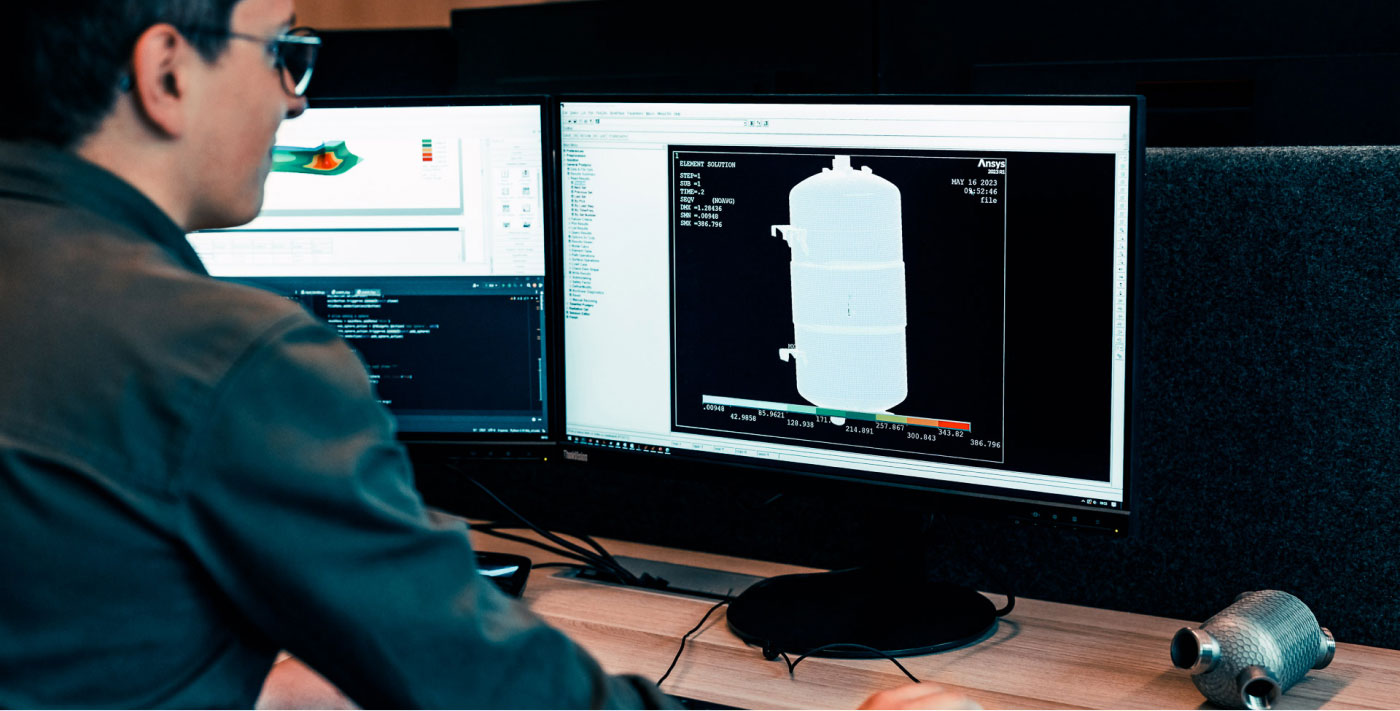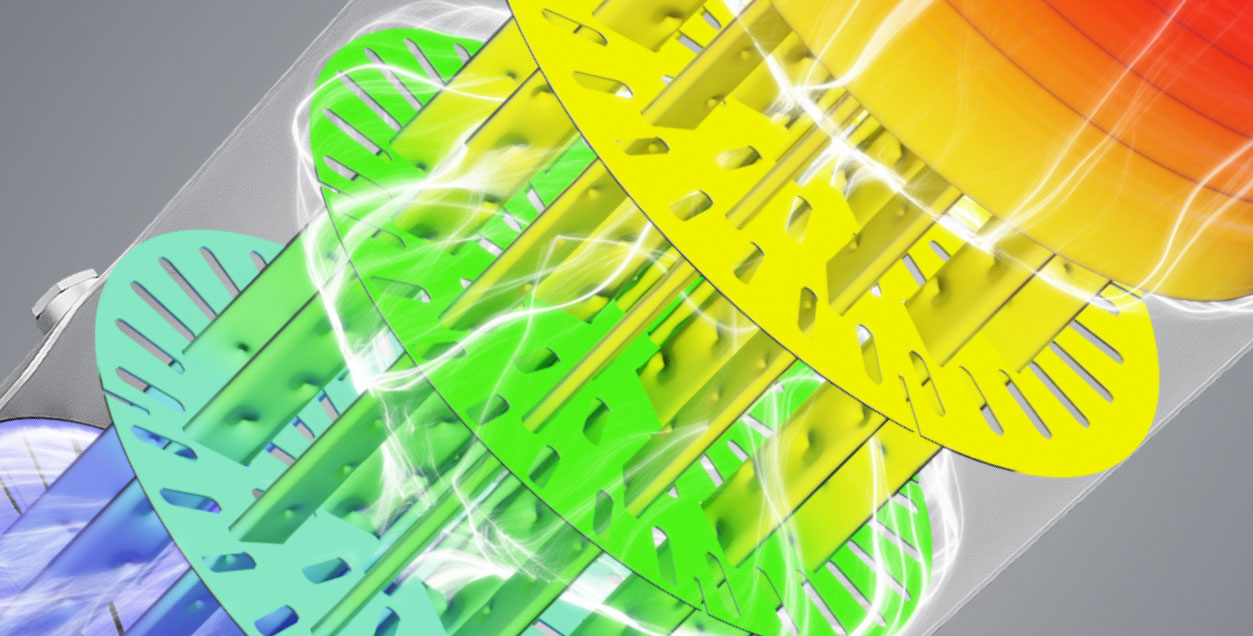CFD & FEA Analysis
Advanced numerical simulations
supporting product design.
Advanced numerical analysis is an essential part of the design process, as it delivers accurate solutions in terms of efficiency, reliability, and performance the of a product.
Overview
The CFD & FEA teams of experienced and skilled engineers, supported by ANSYS software, are able to handle a broad range of heat exchanger design challenges and support product optimization.
CFD Simulations
The CFD division analyzes fluid flow and heat transfer-related issues. The advanced numerical analysis allows our engineers to predict the behavior of specific fluids in various processes and under different conditions. CFD analysis supports product optimization by identifying and eliminating issues that are strictly related to heat transfer and fluid flow, such as thermal efficiency, proper fluid distribution phase transformations, combustion processes, and many more, that could potentially lead to product failure and disturbed operation.
FEA Simulations
FEA is a numerical method for analyzing and predicting the behavior of structures and systems under various conditions. It allows for the prediction of a structure's stress, strain, and dislocation resulting from the influence of such factors as pressure, temperature, or external loads. FEA analysis supports product optimization by identifying and eliminating weak points of structure that could be a source of structural failures, such as cracking, deforming, and many more.


Advantages of CFD & FEA Analysis
CFD & FEM analysis are perfect tools to improve and optimize the design process of heat transfer-related devices.
The most important advantages of conducting CFD & FEA numerical analysis are as follows:
- The reduction in of the overall design time and costs thanks to the ability to perform flow and mechanical simulations, such as fatigue analyses, efficiency analyses, and identifying structural weak points, without the need to build a device.
- The possibility to run unconstrained analyses of the device’s operating parameters, operating factors and processes.
- The ability to simulate processes that are difficult to verify with a manufactured heat exchanger: flow distribution and velocity, temperature analysis inside the device, and phase transitions.
- The numerical analysis enables a more accurate understanding of all processes taking place in a given device, as well as its behaviour and performance in a given application.
CFD Simulations
We use CFD analysis
in the following areas.
- Modeling problems range from 2-D steady laminar flows to 3-D unsteady turbulent flow (RANS/LES) also including single-phase flow and multiphase flow with high performance computing clusters to run complex simulations
- Advanced and detailed chemistry models: simulation of the combustion of the blend: CH4/H2 with CO and NOx emission, electrochemical reactions, catalytic combustion processes
- Sensitive analysis that uses CFD parametrical study and optimization analysis to statistically determine fluid dynamics inside the device
- Reduced virtual dynamic models for Digital Twins on the system level
- Modeling calcium carbonate deposition to detect thermal expansion and loss of cooling water by failure mode-fouling process in heat exchangers
- Performing DBA Part 5 of ASME VIII-2 or Level 3 Fitness-For-Service Assessment per API 579 using CFD in transient FSI thermal-mechanical fatigue analysis, verification, and validation in computational analysis
- Development of the Digital Twin - IoT of devices with lab data and large data set from parametrical analysis, which gives us possibilities to build a Digital Twin with an interactive human interface device for real objects
FEA Simulations
We use FEA analysis
in the following areas.
Static simulations
Applied to model and analyze the structural behavior of the system under loading that does not change over time (stationary loading).
Dynamic simulations
Applied to model and analyze the structural behavior of a system under loading that changes over time (non-stationary loading) due to time-varying internal or external factors.
Fatigue simulations
Applied to predict the allowable number of cycles for given operating conditions by modeling the structural behavior of objects during cyclic operation. These simulations may also include the modeling of defects in a structure, known as fracture mechanics simulations, to determine inspection intervals and critical defect sizes for safe operation.
Electromechanical simulations
Applied to model the interaction between mechanical and electrical systems.
Thermomechanical simulations
Applied to model the behavior of objects under conditions involving heat exchange and phase transitions, including isothermal or temperature difference conditions.
High-speed or "explicit" simulations
Applied to model the behavior of objects during highly nonlinear and high-speed events, such as impacts, explosions, and material failure.
Friction and wear-out simulations
Applied to model the behavior of objects, such as their wear-out in contact situations.
Complex "multiphysics" simulations
Applied to model multiple physical phenomena within a single simulation.
CFD&FEA and Thermal Lab Cooperation
We take full advantage of having the CFD & FEA Division and Thermal Laboratory under one roof to optimize numerical analysis.
We use the capacity of our thermal laboratory to run empirical verification of product performance by conducting a range of comprehensive tests. Gathering the test results and comparing them with numerical simulations allows us to identify the area of improvement where CFD and FEM analysis are not accurate enough to reflect the actual product performance. Thanks to that, we can redefine and improve numerical analysis by adjusting parameters, such as boundary conditions, meshing models or calculation methods.
The entire process is as the following:
Step 1.
Conducting numerical analysis as a part of the designing process
Step 2.
Conducting empirical tests on physical product
Step 3.
Gathering results and comparing with numerical analysis
Step 4.
Identifying areas for improvement
Step 5.
Optimizing numerical analysis
All the above actions lead to constant numerical analysis optimisation by improving their accuracy and thus helping to design reliable and efficient products.